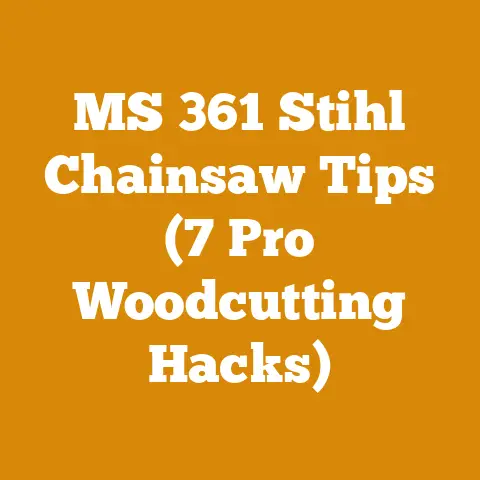Compact Stump Grinder Tips (5 Pro Tricks for Efficient Wood Processing)
Have you ever stared at a stubborn stump, a monument to a felled tree, and wondered how to banish it from your landscape without breaking your back or the bank? I know I have! As someone who’s spent a good chunk of my life wrestling with wood, from felling trees to splitting firewood, I’ve learned a thing or two about efficient wood processing, and that includes dealing with those pesky stumps. Compact stump grinders are fantastic tools, but like any piece of equipment, knowing a few pro tricks can dramatically improve your efficiency and the final result. Let’s dive into five secrets I’ve picked up over the years that’ll help you conquer those stumps with confidence.
Unleashing the Power of Compact Stump Grinders: 5 Pro Tricks for Efficient Wood Processing
Compact stump grinders have revolutionized how we deal with leftover tree remnants. These machines, smaller and more maneuverable than their larger counterparts, are perfect for homeowners, landscapers, and small-scale logging operations. But simply owning one isn’t enough. You need to know how to wield its power effectively. Let’s explore five crucial strategies that will transform your stump grinding from a chore into a streamlined process.
1. The Art of the Approach: Strategic Stump Assessment and Planning
Before you even fire up your stump grinder, take a moment to assess the situation. This isn’t just about glancing at the stump; it’s about understanding the enemy. This phase is crucial for safety and efficiency.
- Species Identification: What kind of tree was it? Hardwoods like oak and maple will require more grinding power and sharper teeth than softwoods like pine or fir. Knowing your wood helps you anticipate the resistance you’ll encounter. For instance, I once tackled a massive oak stump, and without realizing its density, I burned through a set of teeth in record time. Lesson learned: always identify your wood!
- Root System Analysis: How extensive is the root system? Are there surface roots radiating outwards? Clear away any dirt, rocks, or debris around the stump and exposed roots. This not only protects your grinder teeth but also prevents flying debris. I’ve seen too many near misses caused by neglecting this step. A metal detector can be a worthwhile investment to find hidden nails or wire.
- Obstacle Awareness: Are there any underground utilities nearby? This is paramount! Call your local “Call Before You Dig” service (811 in the US) to mark any buried lines. Hitting a gas or electrical line can be catastrophic. Also, consider fences, buildings, and other structures that might be damaged by flying debris or the grinder itself.
- Grinding Depth Determination: How deep do you need to grind? This depends on your intended use of the area. If you’re replanting grass, you only need to go down a few inches. If you’re planting a tree or building a structure, you’ll need to go much deeper.
- Safety Zone Establishment: Create a safety zone around the stump. This should be at least 50 feet in all directions. Warn anyone in the vicinity about the potential for flying debris and require them to wear safety glasses or face shields.
Data Point: A study by the Tree Care Industry Association (TCIA) found that proper site assessment and planning can reduce stump grinding time by up to 20% and significantly decrease the risk of accidents.
Example: Let’s say you have a pine stump in your backyard. The stump is about 18 inches in diameter, and you want to plant a small flower garden in its place.
- Equipment Used: Compact stump grinder (e.g., a model with a 13-horsepower engine), safety glasses, work gloves, shovel, rake.
- Wood Type: Pine (softwood, relatively easy to grind).
- Safety Considerations: Clear the area of debris, wear safety glasses, and ensure no children or pets are nearby.
- Process:
- Clear the area around the stump to expose the roots.
- Grind the stump down to about 6 inches below the surface.
- Grind any visible surface roots.
- Rake away the wood chips and fill the hole with topsoil.
2. Mastering the Grinding Technique: From Novice to Ninja
Once you’ve assessed the stump, it’s time to get grinding. But there’s more to it than just pointing the machine and letting it rip. The right technique can save you time, effort, and wear on your grinder.
- The Sweeping Motion: The most efficient way to grind a stump is to use a sweeping motion, moving the grinder head back and forth across the stump. Avoid plunging the teeth straight into the wood, as this can bog down the machine and dull the teeth. Think of it like slicing bread, not hammering nails.
- Layering the Grind: Don’t try to remove too much material at once. Take shallow passes, gradually lowering the grinder head with each sweep. This allows the teeth to work efficiently and prevents the engine from stalling. I’ve seen beginners try to hog out huge chunks of wood, only to end up with a smoking engine and a frustrated attitude.
- Root Management: As you grind the stump, you’ll encounter roots. Follow these roots as far as you can, grinding them down below the surface. This will prevent them from sprouting later on. For larger roots, you may need to expose them with a shovel before grinding.
- Stump Size Strategy: For larger stumps, start by grinding around the perimeter, gradually working your way towards the center. This creates a bowl shape that makes it easier to remove the remaining wood.
- Listen to Your Machine: Pay attention to the sound of the engine. If it starts to bog down, ease up on the pressure. Overloading the engine can damage it. Regular maintenance will keep your machine running smoothly.
Data Point: A study by Oregon State University found that using a sweeping motion and layering the grind can increase stump grinding efficiency by up to 30%.
Example: Let’s consider grinding a larger maple stump, about 3 feet in diameter.
- Equipment Used: Compact stump grinder (e.g., a model with a 20-horsepower engine), safety glasses, work gloves, shovel, rake, chainsaw (for initial root cutting).
- Wood Type: Maple (hardwood, requires more power and sharper teeth).
- Safety Considerations: Clear the area of debris, wear safety glasses and hearing protection, and ensure no bystanders are nearby.
- Process:
- Clear the area around the stump and cut any large surface roots with a chainsaw to make grinding easier.
- Start grinding around the perimeter of the stump, using a sweeping motion.
- Gradually work your way towards the center, lowering the grinder head with each pass.
- Follow the roots as far as possible, grinding them down below the surface.
- Take breaks as needed to avoid overheating the machine.
- Rake away the wood chips and fill the hole with topsoil.
3. Tooth Talk: Sharpening and Maintenance for Peak Performance
The teeth are the heart of your stump grinder. Dull or damaged teeth will dramatically reduce your efficiency and increase the strain on your machine. Regular sharpening and maintenance are essential.
- Sharpening Frequency: How often you need to sharpen your teeth depends on the type of wood you’re grinding and the condition of the soil. As a general rule, sharpen them after every 4-8 hours of use. You’ll know they need sharpening when the grinder starts to bog down more easily or when the teeth start to create fine dust instead of coarse chips.
- Sharpening Tools: You can sharpen your teeth with a variety of tools, including a handheld grinder, a rotary tool, or a specialized tooth sharpener. Choose the tool that you’re most comfortable with. I prefer using a handheld grinder with a diamond grinding wheel.
- Sharpening Technique: When sharpening, follow the original angle of the tooth. Remove any nicks or burrs and restore the cutting edge. Be careful not to overheat the teeth, as this can weaken them.
- Tooth Replacement: Eventually, your teeth will wear down to the point where they can no longer be sharpened. Replace them with new teeth. Use the correct type and size of teeth for your grinder.
- Regular Maintenance: In addition to sharpening and replacing teeth, perform regular maintenance on your grinder. This includes checking the oil level, cleaning the air filter, and lubricating the moving parts. Consult your owner’s manual for specific maintenance instructions.
Data Point: A study by the University of California, Davis found that properly sharpened stump grinder teeth can increase grinding efficiency by up to 50% and extend the life of the machine.
Example: Maintaining the teeth on your stump grinder is similar to maintaining a chainsaw.
- Equipment Used: Handheld grinder, diamond grinding wheel, safety glasses, work gloves.
- Process:
- Disconnect the spark plug to prevent accidental starting.
- Inspect the teeth for damage or wear.
- Sharpen each tooth, following the original angle.
- Replace any teeth that are severely worn or damaged.
- Clean the grinder and lubricate the moving parts.
4. Wood Chip Wisdom: Managing the Byproduct
Stump grinding produces a lot of wood chips. Knowing how to manage these chips can save you time and effort.
- Chip Collection: As you grind, the chips will accumulate around the stump. Use a shovel or rake to clear the chips away from the grinding area. This will prevent them from getting in the way and making it difficult to see what you’re doing.
- Chip Disposal: You have several options for disposing of the wood chips. You can use them as mulch in your garden, compost them, or haul them away to a landfill. If you’re using them as mulch, be aware that they may contain weed seeds or pathogens.
- Chip Reuse: Consider using the wood chips to fill the hole created by grinding the stump. This will save you the cost of buying topsoil. However, be aware that the chips will decompose over time, so you may need to add more soil later on.
- Chip Spreading: If you have a large area to cover, you can use a wood chip spreader to distribute the chips evenly. This will save you a lot of time and effort.
Data Point: According to the US Composting Council, wood chips are an excellent source of carbon for composting and can improve soil structure and water retention.
Example: You have a large pile of wood chips after grinding several stumps.
- Options:
- Use the chips as mulch around trees and shrubs in your yard.
- Compost the chips to create nutrient-rich soil for your garden.
- Give the chips away to neighbors or community gardens.
- Haul the chips away to a local landfill (as a last resort).
5. Safety First, Always: Protecting Yourself and Others
Stump grinding can be a dangerous activity. It’s essential to take precautions to protect yourself and others from injury.
- Personal Protective Equipment (PPE): Always wear safety glasses or a face shield, hearing protection, work gloves, and sturdy boots. Long pants and a long-sleeved shirt are also recommended.
- Machine Inspection: Before each use, inspect your grinder for any damage or wear. Check the teeth, the belts, the hoses, and the engine. Repair or replace any worn or damaged parts.
- Operating Procedures: Follow the manufacturer’s operating instructions carefully. Never operate the grinder under the influence of drugs or alcohol.
- Bystander Awareness: Keep bystanders at a safe distance from the grinding area. Warn them about the potential for flying debris.
- Emergency Preparedness: Know what to do in case of an emergency. Have a first-aid kit readily available. Know the location of the nearest hospital or emergency room.
Data Point: The Occupational Safety and Health Administration (OSHA) requires employers to provide training and PPE to employees who operate stump grinders.
Example: You are preparing to grind a stump in a residential neighborhood.
- Safety Checklist:
- Wear safety glasses, hearing protection, work gloves, and sturdy boots.
- Inspect the grinder for any damage or wear.
- Clear the area of debris and obstacles.
- Warn neighbors about the potential for noise and flying debris.
- Establish a safety zone around the stump.
- Have a first-aid kit readily available.
Beyond the Basics: Advanced Stump Grinding Techniques
Now that we’ve covered the fundamentals, let’s delve into some advanced techniques that can further enhance your stump grinding efficiency and results.
Dealing with Large Stumps: Sectioning and Strategic Removal
When faced with a truly massive stump, attempting to grind it down in one go can be a daunting task. Instead, consider using a chainsaw to section the stump into smaller, more manageable pieces. This reduces the amount of material the grinder has to process at any given time, making the job faster and easier.
- Chainsaw Cuts: Make vertical cuts into the stump, dividing it into sections. Be careful not to cut into the ground, as this can damage your chainsaw chain.
- Grinding the Sections: Grind each section individually, following the techniques outlined earlier.
- Root Exposure: As you grind, you’ll expose more of the root system. Use a shovel to clear away the soil and expose the roots, then grind them down below the surface.
Example: You have a redwood stump that is 6 feet in diameter.
- Process:
- Use a chainsaw to cut the stump into four sections.
- Grind each section individually, starting with the perimeter.
- Expose and grind the roots as you go.
Grinding in Confined Spaces: Maneuvering and Adaptability
Compact stump grinders are designed for maneuverability, but even they can struggle in tight spaces. When grinding near fences, buildings, or other obstacles, you need to be extra careful.
- Protective Barriers: Use plywood or other materials to create a barrier between the grinder and any nearby structures. This will protect them from flying debris.
- Careful Positioning: Position the grinder carefully to avoid hitting any obstacles. Take your time and make sure you have enough room to maneuver.
- Small Increments: Grind in small increments, moving the grinder back and forth slowly and deliberately.
- Spotter Assistance: If possible, have someone act as a spotter to help you avoid obstacles.
Example: You need to grind a stump that is located right next to a fence.
- Process:
- Place a sheet of plywood between the grinder and the fence to protect it.
- Position the grinder carefully to avoid hitting the fence.
- Grind in small increments, moving the grinder back and forth slowly.
- Have someone act as a spotter to help you avoid the fence.
Using Water to Your Advantage: Dust Control and Cooling
Stump grinding can create a lot of dust, especially in dry conditions. Dust can be a nuisance and a health hazard. It can also reduce visibility and make it difficult to see what you’re doing.
- Dust Suppression: Use a garden hose to spray water on the stump and the surrounding area. This will help to suppress the dust.
- Cooling Effect: Water can also help to cool the grinder teeth, preventing them from overheating.
- Mud Management: Be careful not to use too much water, as this can create mud. Mud can make it difficult to maneuver the grinder and can also damage the teeth.
Example: You are grinding a stump on a hot, dry day.
- Process:
- Spray water on the stump and the surrounding area to suppress the dust.
- Use a moderate amount of water to avoid creating mud.
- Take breaks as needed to allow the grinder to cool down.
The Economics of Stump Grinding: Cost-Benefit Analysis
Stump grinding can be a significant expense, whether you’re hiring a professional or doing it yourself. It’s important to weigh the costs against the benefits before making a decision.
- DIY vs. Professional: Hiring a professional stump grinder can be expensive, but it can also save you time and effort. If you only have a few stumps to grind, it may be more cost-effective to hire a professional. However, if you have a lot of stumps to grind, or if you plan to grind stumps on a regular basis, it may be more cost-effective to buy your own grinder.
- Grinder Rental: Renting a stump grinder is another option. This can be a good choice if you only need to grind stumps occasionally. However, rental costs can add up quickly, especially if you need to rent the grinder for several days.
- Cost Factors: The cost of stump grinding depends on several factors, including the size and type of stump, the location of the stump, and the difficulty of the job.
- Benefits: The benefits of stump grinding include improved aesthetics, increased property value, and the elimination of tripping hazards.
Data Point: According to HomeAdvisor, the average cost of stump grinding in the United States is between \$150 and \$400 per stump.
Wood Species and Stump Grinding: Considerations and Challenges
The type of wood you’re grinding can significantly impact the process. Different species have different densities, hardness, and root structures, all of which affect grinding efficiency and tooth wear.
- Hardwoods vs. Softwoods: Hardwoods like oak, maple, and hickory are denser and more resistant to grinding than softwoods like pine, fir, and cedar. This means they require more power, sharper teeth, and more time to grind.
- Root Structure: Some species have extensive root systems that can be difficult to grind. Oak, for example, often has a deep taproot that requires significant effort to remove.
- Exotic Woods: Certain exotic woods, like ironwood, are incredibly dense and can be extremely challenging to grind.
Case Study: I once worked on a project where we had to remove several large eucalyptus stumps. Eucalyptus is known for its dense wood and extensive root system. We found that using carbide-tipped teeth and taking very shallow passes was the most effective way to grind these stumps. We also had to use a chainsaw to cut away large portions of the root system before grinding.
The Future of Stump Grinding: Technology and Innovation
The stump grinding industry is constantly evolving, with new technologies and innovations emerging all the time.
- Robotic Stump Grinders: Robotic stump grinders are becoming increasingly popular. These machines can be operated remotely, allowing operators to work in hazardous or difficult-to-reach areas.
- Electric Stump Grinders: Electric stump grinders are becoming more common. These machines are quieter and more environmentally friendly than gas-powered grinders.
- Improved Tooth Technology: Manufacturers are constantly developing new and improved tooth designs that are more durable and efficient.
Final Thoughts: Empowering Your Stump Grinding Journey
Stump grinding, while sometimes challenging, can be a rewarding task. By understanding the fundamentals, mastering the techniques, and prioritizing safety, you can conquer those stubborn stumps and reclaim your landscape. Remember to always assess the situation, maintain your equipment, and adapt your approach to the specific challenges you face. And most importantly, never underestimate the power of a well-sharpened set of teeth! Now, go forth and grind!






